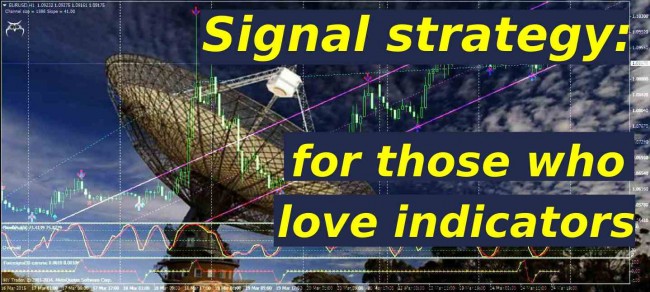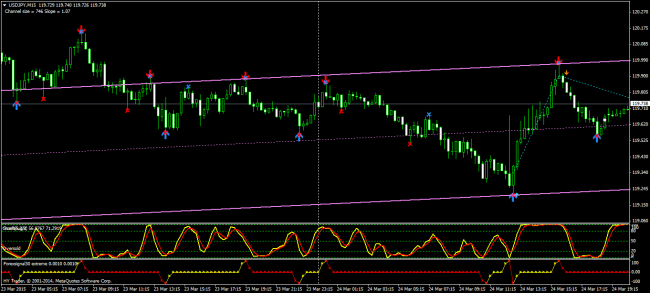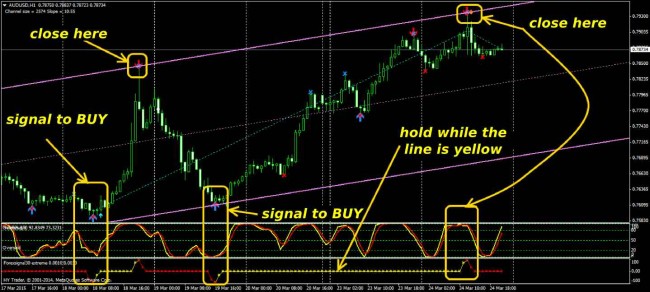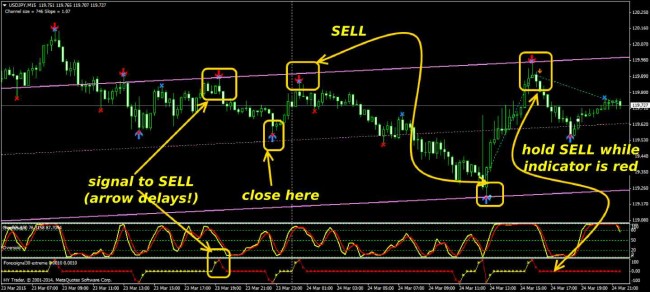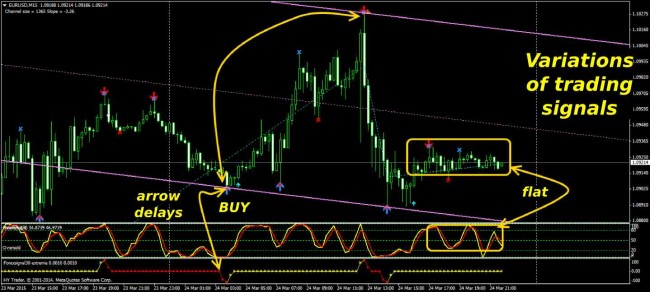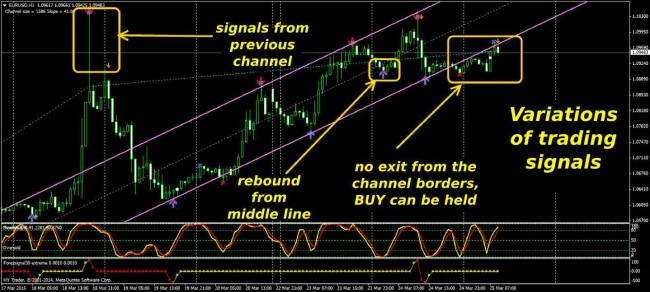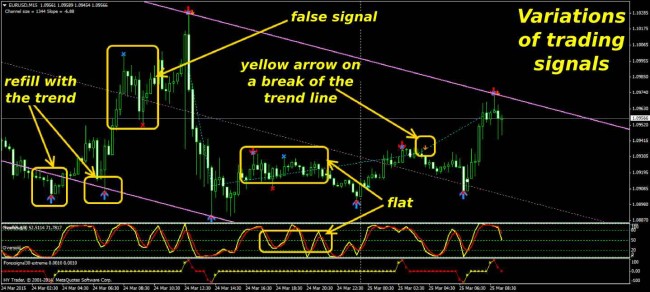Another variation of successful combination of all types of technical indicators for channel trading in a single set. The Signal strategy works quite stably for trading on the rebound from the borders in the intraday channel on standard instruments – both in a trending market and during the flat.
Channel strategies in their logic are using the fact that the price almost always moves in a certain range, and its width depends on the period in which it is built. If there is a price range from 50 points (even on the flat), the channel strategies allow to consistently take 20-30 points from the market from each transaction on any instrument. The main thing is correct building the channel boundaries and filtering the entry signals using additional indicators.
This set of indicators was chosen in practice by the trader who really wanted to switch from active scalping on M5-M15 to medium-term trading from one hour, but with keeping his usual indicators and trading skills. The result was a Signal strategy.
Installing and configuring the indicators
All is installed in a standard way: copy forexsignal30.tpl template file to a folder …\MetaTrader\templates, indicator files (*.ex4) – to …\MetaTrader\MQL4\Indicators.
After restart of the terminal, we select the forexsignal30 template and see something like this on the chart:
The strategy includes:
- forexsignal30.2 – trend indicator (apparently based on ZigZag), which tracks short-term trend (parameters 55/17 are better not to change);
- forexsignal30.3 – indicator of the equidistant trend channel, built automatically at max/min prices, increase/decrease in the indicator parameters lead to a narrowing/expansion of the boundaries;
- forexsignal30.4 – signal indicator "painting" arrows/crosses at key points of opening/closing; the parameter contains only the number of bars for calculation;
- 2 interconnected oscillators in additional windows – standard Stochastic and Forexsignal 30 extreme.
Trend and signal indicators have minimal balanced set of parameters; the most important indicator in the Signal strategy appears to be Stochastic, as the lowest indicator confirming the signal to enter is calculated on its basis.
The test was conducted on the standard settings. For more volatile instruments, you can experiment with the parameters of the stochastic. For periods of H1 and above, you can increase the number of bars for calculation (parameter in the forexsignal30.4 indicator).
Use in trading
According to this Signal strategy, all medium-volatile pairs are traded fine: EUR/USD, GBP/USD, AUD/USD, USD/CAD, you can also try futures in non-speculative time.
Recommended trading period: M15 and above.
Trading is conducted on the rebound from the borders or from the middle line of the price channel built by indicators according to the entry (arrow) and close (cross) signals that appear.
If the current price channel is steadily broken, the system automatically adjusts and creates a new channel and a new set of points.
To open for BUY, the following requirements should be met:
- Current price is located at the border of the price channel (bottom);
- Forexsignal30.4 indicator shows big blue up arrow;
- Stochastic is oversold (below 20);
- On the Forexsignal 30 extreme indicator (in the lower window of the chart), the trough down occurs and the color changes from red to yellow.
Important: you can hold the position open as long as the line of the Forexsignal 30 extreme indicator is yellow.
Like this:
Signal strategy opens an order to sell under the following conditions:
- The price should be at the border of the price channel (top);
- Forexsignal30.4 indicator shows a big red down arrow;
- Stochastic is in the overbought area (above 80);
- The Forexsignal 30 extreme indicator forms spike up and the color changes from yellow to red.
Important: you may hold the order as long as the line of the Forexsignal 30 extreme indicator is red.
Like this:
Stops and closing of positions under Signal strategy
Working positions are closed at the appearance of:
- blue cross above the price chart – at an open buy;
- red cross below the chart price – at an open sell.
The size of the stop is recommended 20 points higher/lower than the nearest extreme, according to the interval in which you trade. When moving to breakeven, you can pull the stop with the trailing at a distance of 20 points from the line of a short-term trend.
Important: apparently, the level of automatic stops is not regulated in the indicators of the Signal strategy, so they are set on the basis of money management rules.
Some practical remarks
The emergence of "crosses" to close sometimes occurs illogically early, so do not hurry to quit if the price is still moving inside the channel and in the direction of short-term trend built by the forexsignal30.2 indicator.
Most often, a signal to close coincides with the rebound from the boundaries of the channel, so you can use the reversal order instead of the stop.
Important: like in all indicator strategies, the situation should be assessed comprehensively, because the appearance of the arrows is usually ahead of the appearance of the spike on the 30 Forexsignal extreme indicator.
Sometimes small yellow arrows appear on the chart together with the big blue/red arrows for entry – they are signals of the current break of the internal short-term trend built by the forexsignal30.2 indicator and are not a signal for action.
Important: at the time of appearance, the arrows (to enter) and crosses (to exit) are ahead or late to the appearance of the corresponding signal (spike or trough) on the Forexsignal 30 extreme indicator, but it is recommended to focus precisely on the signal when making decision.
And as a conclusion...
This Signal strategy is a typical option to trade within the channel. It is universal on the part of trading tools and easy to use, despite the motley set of indicators.
The disadvantages include almost the complete lack of ability to fine tune, but it works with default settings quite profitably on a standard, technical market. The signals to enter/exit from various indicators of the strategy are poorly synchronized – after all, one of the basic indicators is stochastic.
However, this can even go for good for a trader: in the period between occurrences of signals you will have more time to make a decision. If correctly follow the requirements of the strategy, even a trader with minimal experience can consistently earn with it. Source: Dewinforex
Social button for Joomla



